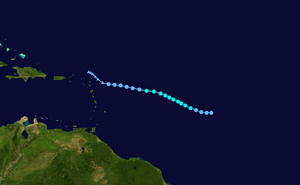Tropical Storm Ingrid (2007) facts for kids
| Tropical storm (SSHWS/NWS) | |

Tropical Storm Ingrid at peak intensity in the open Atlantic.
|
|
| Formed | September 12, 2007 |
|---|---|
| Dissipated | September 17, 2007 |
| Highest winds | 1-minute sustained: 45 mph (75 km/h) |
| Lowest pressure | 1004 mbar (hPa); 29.65 inHg |
| Damage | None |
| Areas affected | Northern Lesser Antilles |
| Part of the 2007 Atlantic hurricane season | |
Tropical Storm Ingrid was a weak tropical storm that formed in the Atlantic Ocean in September 2007. It was the ninth named storm of the 2007 Atlantic hurricane season. Ingrid started as a "tropical depression," which is like a baby storm.
Another storm, Tropical Depression Nine, formed around the same time. That one grew much faster and became Hurricane Humberto. Ingrid, however, stayed weak and only lasted for a short time. It got weaker over the Atlantic Ocean because of strong wind shear, which is when winds blow in different directions and stop a storm from growing. Ingrid faded away before it could reach any land. It did bring some rain to islands like Saint Martin and Antigua.
Contents
How Tropical Storm Ingrid Formed and Moved
Ingrid began as a large tropical wave that moved away from the coast of west Africa on September 6. For a few days, it couldn't get stronger because of strong winds blowing in different directions. On September 9, a low-pressure area formed in the middle of the Atlantic. This was between Africa and the Lesser Antilles islands.
Slowly, the strong winds started to calm down. By September 12, this weather system had grown into Tropical Depression Eight. This happened about 1,125 kilometers (700 miles) east of the Lesser Antilles. The same tropical wave also helped create another storm, which became Tropical Depression Ten.
Ingrid's Path and Strength
For most of its life, Ingrid moved toward the west-northwest. It stayed along the southern edge of a weather system called a ridge. Strong wind shear made it hard for Ingrid to get much stronger. It remained a tropical depression for a full day. Then, early on September 13, it finally became a weak tropical storm.
Ingrid continued to get a little stronger that afternoon. It reached its highest strength that evening, with winds of about 75 kilometers per hour (45 miles per hour).
Why Ingrid Weakened
Ingrid could not get much stronger because of very strong wind shear. This wind shear came from a high-level weather system called a tropical upper tropospheric trough. Even with these strong winds, Ingrid stayed a weak tropical storm until the afternoon of September 15.
Then, it weakened back into a tropical depression while it was east of the Leeward Islands. Ingrid kept getting weaker as it passed northeast of these islands. It still had some strong thunderstorms, but it was very disorganized. The storm became a little more organized for a short time on September 16. However, this didn't last long. Ingrid became very disorganized again that afternoon and kept getting weaker.
The National Hurricane Center announced that Ingrid had weakened into a tropical wave early on September 17. This happened while it was still north of the Leeward Islands. The leftover parts of the storm moved northwest and completely disappeared on September 18.
What Happened Because of Ingrid
Ingrid stayed just east and northeast of the Lesser Antilles. It weakened without hitting any land directly. The leftover parts of the storm brought some rain and thunder to Antigua.
On Saint Martin, Ingrid caused about 38 millimeters (1.5 inches) of rain in just an hour. This caused some roads to become flooded. Luckily, the storm did not cause any damage or deaths. No ships reported strong winds from the storm either.
Because Tropical Storm Ingrid caused no damage, its name was not removed from the list of tropical cyclone names. This means the name "Ingrid" could be used again for a storm in the future, for example, during the 2013 Atlantic hurricane season. This was the first time the name "Ingrid" was used for an Atlantic storm. However, the name has been used for storms in other parts of the world.
Related Pages
- 2007 Atlantic hurricane season
- Tropical cyclone
- Tropical Storm Melissa (2007), a storm like Ingrid
- NHC's archive on Tropical Storm Ingrid


